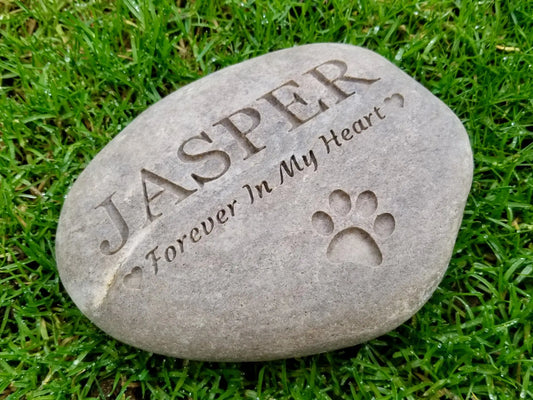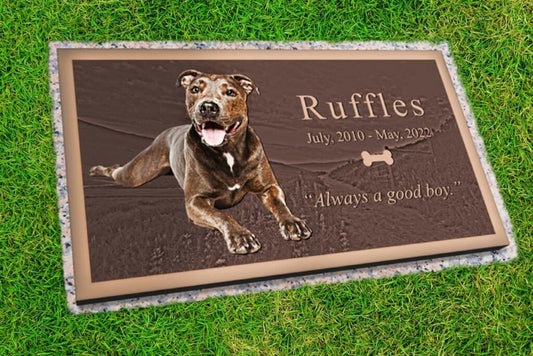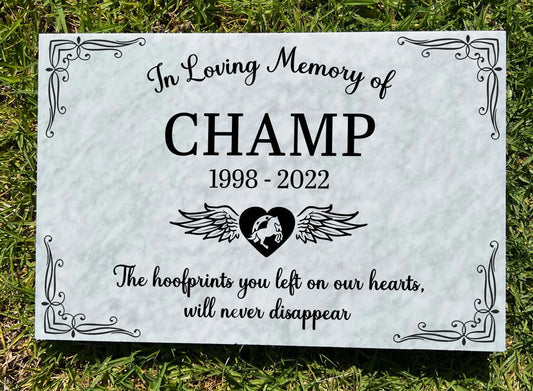Discover the essential factors for choosing the perfect pet grave marker, from materials and personalization to legal considerations and pricing.
This expert guide helps pet owners make informed decisions about creating meaningful, lasting memorials for their beloved companions.
The Hidden Challenges of Memorializing a Pet
Losing a pet creates an emotional void that many non-pet owners fail to understand.
Research from the Human-Animal Bond Research Institute shows that 85% of pet owners consider their animals family members, yet society provides few formal structures for grieving these losses.
The decision to create a permanent memorial isn't just emotional, it's practical too, helping to establish closure and providing a dedicated space for remembrance.
Material Considerations: What Truly Lasts Outdoors
The material you select determines your pet memorial's longevity:
Granite and stone: Withstand decades of exposure (25+ years) with minimal maintenance, though premium pricing ($75-400+) reflects this durability
Bronze and metal: Offer elegance but require periodic maintenance to prevent oxidation and patina development
Resin and composite: Provide affordability ($30-100) with impressive detail but typically last only 5-10 years before showing significant weathering
Biodegradable options: Designed to return to nature over 1-5 years, ideal for environmentally-conscious pet owners
According to conservationists at the International Cemetery, Cremation and Funeral Association, granite remains the gold standard for outdoor memorials due to its resistance to acid rain, temperature fluctuations, and biological growth.
Personalization Elements That Matter Most
Analysis of consumer behavior from memorial product retailers reveals the personalization features that create the most meaningful connections:
Photo elements: Laser-engraved photographs now rival traditional printing in durability and detail
Custom text beyond dates: 78% of pet owners include a personal quote or message that captures their pet's personality
Breed-specific design elements: Incorporating visual elements that reflect your pet's specific breed creates instant recognition
Size appropriateness: The memorial size should proportionally honor your pet's physical presence in your life
The most effective personalized pet headstones balance sentimentality with practical considerations about visibility and maintenance.
Legal Considerations Often Overlooked
Before purchasing a pet grave marker, understand the legal framework:
Private property burial regulations: 32 states have specific regulations about backyard pet burial depths and proximity to water sources
HOA and community restrictions: Many homeowners' associations explicitly restrict visible pet memorials in yards
Cemetery-specific rules: Pet cemeteries often have material, size, and design restrictions for consistency
According to the International Association of Pet Cemeteries and Crematories, approximately 750 dedicated pet cemeteries operate in the United States, each with unique restrictions on memorial styles.
Pricing Structure Explained
The price spectrum for pet memorials reflects meaningful differences
| Type | Price Range | Durability | Customization Level |
|---|---|---|---|
|
Basic Resin Markers
|
$30-75 | 5-10 years | Limited text options |
|
Mid-Range Stone
|
$100-250 | 15-25+ years | Text + simple design |
|
Premium Granite/Bronze
|
$250-600+ | 25+ years | Text, designs, photos |
|
Custom Sculptural
|
$500-2,000+ | Material dependent | Fully customized |
Factors most impacting price include material quality, size, engraving complexity, and installation services.
The most cost-effective approach balances material longevity with personalization needs.
Installation Considerations That Save Future Headaches
Professional installers report these key installation factors that most pet owners overlook:
Proper foundations prevent tilting: Without proper leveling and base preparation, markers shift over seasonal freeze/thaw cycles
Location planning: Consider sun exposure (impacts readability), water drainage patterns, and lawn maintenance access
Theft prevention: Sadly, unsecured markers sometimes disappear from public or accessible areas
Future property considerations: If you might move, consider transportable options rather than permanently installed monuments
Design Psychology: What Creates True Comfort
Memorial designers note that the most satisfying pet grave markers share these qualities:
Visual representation of the pet's spirit: Either through imagery or symbolism
Balanced information: Name, dates, and a succinct personal message (typically under 20 words)
Proportional sizing: Neither overwhelming nor underwhelming compared to the pet's physical presence
Weather-resistant readability: Engraving depth and contrast that remains visible after years of exposure
DIY vs. Professional: An Honest Assessment
While DIY pet grave markers offer personalization and cost savings ($15-50 compared to $100+), you could consider these tradeoffs
Durability gap: Homemade concrete markers typically show significant deterioration within 2-5 years
Engraving challenges: Most DIY engraving methods lack the depth needed for long-term legibility
Professional technique advantages: Commercial-grade sealants and engraving technology significantly extend marker life
Time investment: Quality DIY markers require multiple steps with drying/curing time between each
According to Pet Memorial Reviews, approximately 65% of DIY memorial creators express satisfaction initially, but this drops to 30% after two years of weathering.
Environmentally Conscious Options
For environmentally-minded pet owners, these options minimize ecological impact:
River stones: Naturally smoothed stones require minimal processing
Recycled glass markers: Created from post-consumer glass with low-impact coloring techniques
Plantable memorials: Contain wildflower or tree seeds that grow as the marker biodegrades
Solar-powered memorial lights: Provide illumination without wiring or battery disposal issues
The Green Burial Council notes growing interest in biodegradable pet memorials as extensions of eco-conscious living choices.
Maintenance Requirements by Material Type
Understand the long-term care needs before purchasing:
Granite: Annual gentle cleaning with non-acidic stone cleaner
Bronze: Quarterly application of metal protectant to prevent oxidation
Resin/Polymer: Bi-annual sealing to prevent UV damage and cracking
Concrete: Annual sealing to prevent moisture absorption and cracking
Wood: Twice-yearly waterproofing treatment for outdoor applications
Beyond Traditional Markers: Alternative Memorial Approaches
Consider these alternatives that serve the same commemorative purpose:
Living memorials: Tree planting services like The Living Urn offer growing tributes
Memory gardens: Dedicated plant arrangements incorporating small plaques or stones
Memorial benches: Functional memorials that create reflection spaces
Digital memorials: QR-code enabled traditional markers that link to online photo/video galleries
Cremation jewelry: Wearable memorials containing small amounts of cremated remains
Making Your Final Decision
After counseling thousands of grieving pet owners, memorial specialists recommend this decision approach:
Assess your memorial timeframe: Temporary marker while deciding on permanent options?
Evaluate your location permanence: Will you move within 5 years?
Consider your maintenance willingness: How much ongoing care can you commit to?
Define your budget boundaries: Set clear limits before emotional shopping
Identify the most meaningful elements: What absolutely must be included?
Remember that the most effective pet grave markers balance emotional resonance with practical considerations about longevity, maintenance, and placement.
Resources for Further Guidance
These organizations provide additional insights on pet memorialization:
Association for Pet Loss and Bereavement - Grief resources and memorial ideas
The Pet Loss Resource Center - Community support and memorial options
International Association of Pet Cemeteries - Standards and best practices
FAQs
Q1. What is the most durable material for an outdoor pet grave marker?
Granite offers superior longevity (25+ years) with minimal maintenance, making it the ideal choice for permanent outdoor memorials despite its higher cost ($150-600).
For budget-conscious options that still provide decent durability, consider sealed resin markers ($30-100) that typically last 5-10 years before showing significant weathering.
Q2. Can I legally place a pet grave marker in my backyard?
Approximately 32 states have specific regulations regarding backyard pet burials, including depth requirements (typically 3-4 feet) and minimum distances from water sources (usually 100+ feet).
Additionally, many HOAs explicitly prohibit visible pet memorials.
Check your local ordinances and property restrictions before installation to avoid potential removal requirements or fines.
Q3. What's the typical price range for different types of pet memorials?
Pet memorial pricing reflects meaningful differences in durability and customization:
Basic resin markers: $30-75 (5-10 year lifespan)
Mid-range stone: $100-250 (15-25+ years)
Premium granite/bronze: $250-600+ (25+ years with photos/detailed designs)
Custom sculptural pieces: $500-2,000+ (highly personalized)
Q4. What information and design elements create the most meaningful pet grave marker?
The most satisfying pet memorials typically include: the pet's name, lifespan dates, a concise personal message (under 20 words), and a visual element representing your pet (either a breed-specific design or photo).
Memorial designers recommend balancing information with clean design rather than overcrowding the marker with text.
Q5. How do I choose between DIY and professional pet grave markers?
While DIY markers cost significantly less ($15-50 vs. $100+), they typically deteriorate within 2-5 years outdoors.
Professional options offer advantages in engraving depth, material quality, and weatherproofing techniques.
Consider your budget, desired longevity, and crafting abilities honestly before choosing - many pet owners report satisfaction with DIY options declining sharply after two years of weathering.
Q6. What environmentally-friendly options exist for pet grave markers?
Eco-conscious options include river stones (minimal processing), recycled glass markers, plantable memorials containing wildflower or tree seeds, and solar-powered memorial lights.
Q7. How should I install my pet's grave marker to prevent damage or shifting?
Professional installers recommend creating a level base using 2-3 inches of compacted gravel covered by 1-2 inches of sand before placement.
For larger markers, consider a concrete foundation. Position markers away from areas prone to water pooling, and in regions with freeze/thaw cycles, install slightly above ground level to prevent frost heaving that can crack or tilt the memorial over time.
Q8. What maintenance will different types of pet grave markers require long-term?
Material-specific maintenance requirements include
Granite: Annual cleaning with non-acidic stone cleaner
Bronze: Quarterly application of metal protectant
Resin/Polymer: Bi-annual sealing against UV damage
Concrete: Annual sealing to prevent moisture absorption
Wood: Twice-yearly waterproofing for outdoor use
Q9. What alternatives exist if I can't have a traditional grave marker?
For those renting, planning to move, or facing restrictions, consider
Living memorials (dedicated trees or plants), memorial benches in pet-friendly parks (often available through donation programs), digital memorials with QR codes linking to online tributes, or cremation jewelry containing a small portion of remains, which provides a portable memorial option.
Q10. How do I include a photo of my pet on their grave marker that will last?
For photo inclusion, laser-engraved images on granite provide the best outdoor durability (20+ years).
Ceramic photo inserts offer excellent detail but may require replacement after 7-10 years outdoors.
Avoid printed photos under resin for outdoor use, as UV exposure typically causes fading within 1-3 years even with protective coatings.
Consider the viewing distance when selecting photo size - most viewers stand 2-3 feet from markers.




